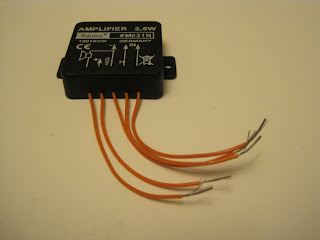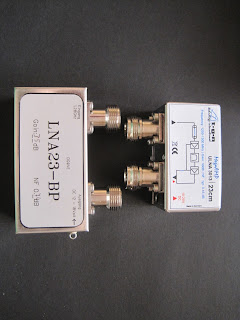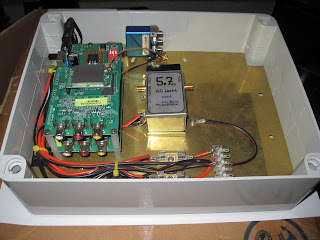Hello and welcome to xtract 018m of the HX Files.
In this issue a 20 watt transmitter with a built in receiver.
This project would be a unit that would be, not to make little of It, a spare transmitter and receiver, and instead of it being left at home, it was to be brought with the main portable transceiver (see photo I below)
 |
| Picture 1, Photo of main rig |
just in case anything happened to the main transmitter or receiver. It would be setup as a transmitter, so if needed it could be used straight away. The receiver could be switched on while the TX was on, but as they have their own aerial sockets I could monitor the TX signal without an aerial being connected to the receive socket. There was a plan A or B at the start, I had thought of plan B of making It a transceiver, and by simply adding a coaxial relay, TX/RX switch, a couple of phono sockets and patch leads it could be done, but I wanted to make this spare as a backup transmitter and to keep it as such, so I will carry on and build it as plan A and leave plan B for some time in the future.
The case for this project started life as a 100 watt 2m amplifier, and no, it was not converted to 23cms, it was however converted to junk by its previous owner. I did not ask how he let all the smoke out, but I was told that it was beyond repair, so as the whole amplifier was a large heat sink and would be very handy to have, a deal was done and it was placed into the stores, and there the amp rested for a couple of years awaiting a renaissance. (Wow that was deep, it must be Christmas).
The first thing I done was to remove the old circuit board and switches, (I forgot to take a photo), with that done the original front and rear panels were use to mark out the holes for the new panels, including a new bottom one, but before any cutting out was to be done to the panels I had to place the other parts on the heat sink to give me an idea on were to drill to attach the amp, transmitter and the receiver.
 |
In photo 2 on the right, you can see the front panel as a blank on the top, and on the bottom with the holes for the various switches, led’s and a couple of carrying handles that would also act as a guard to protect the front. In photo 3 below left, you can see the parts laid out out in their final position with some of the wiring done, the amp top right and the 50mw driver on the left, the receiver is on the bottom right, also seen is some connecting patch leads.
 |
| Photo 3 |
The amp has some pre drilled holes in its own mounting plate and that with the bonding of the amp to the larger heat sink; the amp was finally attached by marking and drilling straight through the heat sink and using some stainless steel nuts and bolts.
Photo 4 on the left shows the back panel with the amp N type socket on the left, you may notice that the two N sockets are different, one been the fitted socket on the amp and the other one a panel mount N to SMA, I was not going to remove the n type fitting from the amp and attach it to the panel via a small lead or adaptor, so not wanting to remove the N type, a couple of small pieces of the panel was cut out so it would fit around the sockets, and as I had not got the harder files to work on the steel , I can make a new and better rear panel.
Photo 5 on the left is a picture of the almost finished front panel; the 3 switches are for the 20 watt amp on/off, the receiver, and the DC on/off. The switches and led’s will be marked out by the labelling machine when I find it. The 6 led’s are used for the following, the DC power, amp on/off, TX on/off, RX on/off, the amp has a feature that has a DC monitor voltage that can also be used to indicate if the amp is on so I will use that one as well, and not ruling out a time in the future that the unit could be turned into a transceiver I had a spare led for displaying the relay. In photo 5 the finished front can be seen installed on the heat sink, the keen (Hungary) eye amongst you may have noticed that the led’s seem to white, but when the voltage is applied to them some of them light red and the rest green.
That is all for this Xtract of the HX Files, and indeed for 2011, I would like to thank you for the kind words when I met you at the rallies over the year, so with that, I wish you a very Happy Christmas, and a prosperous, and P45 free 2012.
May all your signals be P5.
73’s
Pat.





































